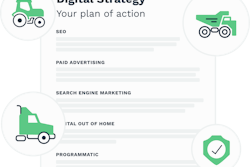
What you need to know:
- California's Clean Truck and Bus Voucher Incentive Project (HVIP) officially reopens on September 9 at 9 a.m. PT.
- What's new: Voucher amounts increased significantly, especially for small fleets, conversion incentives boosted from 50% to 75% of new vehicle voucher value, and a new 540-day delivery window gives fleets more time to receive vehicles amid production delays.
- Only CARB-approved dealers (139 statewide) can process HVIP vouchers.
- The current funding round runs until December 31, 2025.
Commercial vehicle fleets across California have a major opportunity as the state's Clean Truck and Bus Voucher Incentive Project (HVIP) officially reopened on September 9. With 171 zero-emission vehicle models eligible and individual vouchers worth up to $420,000, the program offers attractive financial incentives to electrify commercial fleets—both public and private.
But a key question remains: Will the program's popularity prevail in light of major changes at the federal level, such as the Department of Justice's decision to sue California over the now-defunct Clean Truck Partnership?
[Related: DOJ sues California over Clean Truck Partnership, alleging violation of federal law]
This remains to be seen. However, it's still important for fleets to understand how much they can save when buying new zero-emission vehicles in the Golden State, which vehicle classifications are eligible, and who are the approved dealers.
Since it launched in 2009, HVIP has, according to the California Air Resources Board (CARB), "invested $754 million, helping 2,000 fleets deploy 10,000 clean trucks and buses" and accelerated the adoption of clean transportation.
For fleet operators who have yet to explore zero-emission options, now is the ideal time to make a move. Delaying could mean missing out on significant savings and access to clean vehicles.
What's different for 2025?
This year's HVIP rollout includes major updates that significantly improve the value proposition for commercial fleets considering the switch to zero-emission vehicles.
Small fleet operators, in particular, stand to benefit from increased voucher amounts of up to $330,000 for Class 8 rigs, a substantial boost from previous years. Incentives for vehicle conversions have also been raised to 75% of the new vehicle voucher value, up from 50%, making retrofits more cost-effective. Additionally, the program now offers a 540-day delivery window, giving fleets greater flexibility amid ongoing OEM production delays.
All told, there will be 171 eligible zero-emission models from 36 different manufacturers.
The basics
For small fleets, which are defined as operators with 20 or fewer vehicles and have less than $15 million in annual revenue, the incentive levels are significantly higher for 2025. Eligible fleets can receive the following:
- Up to $330,000 per Class 8 vehicle
- $130,000 to $160,000 per vehicle for Class 4–7
- $9,000 to $40,000 per vehicle for Class 2b–3
However, small fleets are limited to a lifetime maximum of five enhanced vouchers.
Larger fleets, meanwhile, are still eligible for substantial support, with standard voucher amounts including:
- $120,000 per Class 8 vehicle, or $240,000 for hydrogen fuel cell models
- $60,000 to $85,000 for Class 4–7
- $7,500 to $15,000 for Class 2b–3 vehicles
These incentives offer meaningful savings and it's important to understand before applying what your fleet is eligible for and any restrictions. Selecting a qualified dealer is another must.
Eligible dealers
- TEC Equipment
- Tom's Truck Centers
- Range Zero Emissions
- Affinity Truck Center
- Velocity Truck Centers
Before applying
It's vital to have the correct documentation prepared before submitting any grant applications. Wasting time and causing headaches is the last thing anyone wants.
Therefore, make sure your business has been operating in California for at least one year, your registration is current with the California Secretary of State, and your listed domicile address can support vehicle charging or fueling.
To apply, fleets need a signed purchase order, proof of business operations such as a license or tax returns, a designated vehicle domicile location, and full disclosure of all other funding sources.
What about 2026 funding?
This current round of HVIP funding is scheduled to run through December 31, 2025. While CARB is actively developing the 2025–26 Clean Transportation Funding Plan, the future of HVIP funding remains uncertain.
It's likely the program will continue, but how much funding will be available is unclear—especially as Governor Gavin Newsom has signaled major budget cuts to address a projected $12 billion state deficit.











